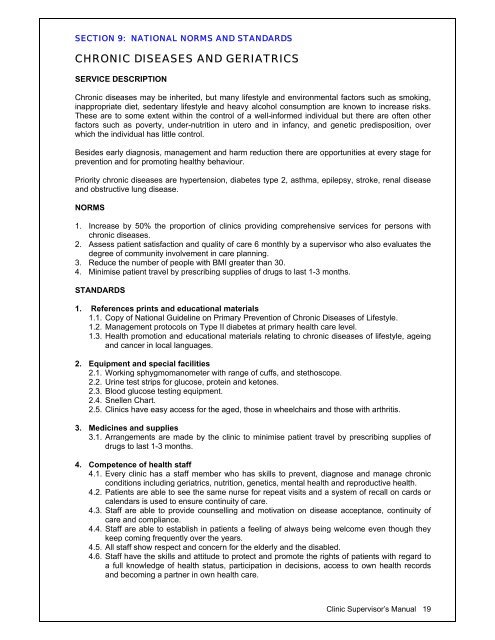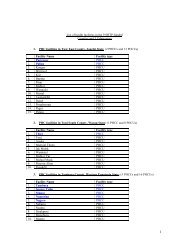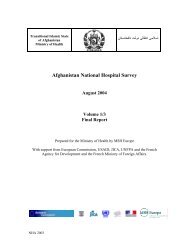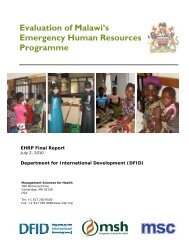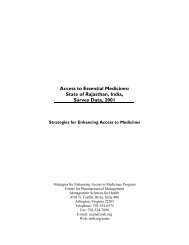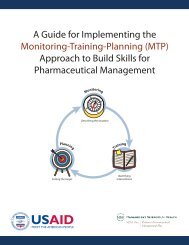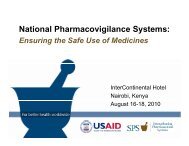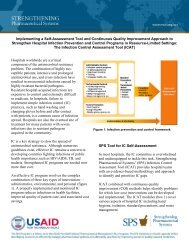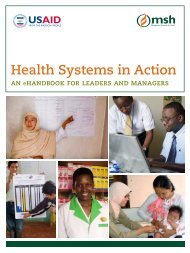CLINIC SUPERVISOR'S MANUAL - Management Sciences for Health
CLINIC SUPERVISOR'S MANUAL - Management Sciences for Health
CLINIC SUPERVISOR'S MANUAL - Management Sciences for Health
You also want an ePaper? Increase the reach of your titles
YUMPU automatically turns print PDFs into web optimized ePapers that Google loves.
SECTION 9: NATIONAL NORMS AND STANDARDS<br />
CHRONIC DISEASES AND GERIATRICS<br />
SERVICE DESCRIPTION<br />
Chronic diseases may be inherited, but many lifestyle and environmental factors such as smoking,<br />
inappropriate diet, sedentary lifestyle and heavy alcohol consumption are known to increase risks.<br />
These are to some extent within the control of a well-in<strong>for</strong>med individual but there are often other<br />
factors such as poverty, under-nutrition in utero and in infancy, and genetic predisposition, over<br />
which the individual has little control.<br />
Besides early diagnosis, management and harm reduction there are opportunities at every stage <strong>for</strong><br />
prevention and <strong>for</strong> promoting healthy behaviour.<br />
Priority chronic diseases are hypertension, diabetes type 2, asthma, epilepsy, stroke, renal disease<br />
and obstructive lung disease.<br />
NORMS<br />
1. Increase by 50% the proportion of clinics providing comprehensive services <strong>for</strong> persons with<br />
chronic diseases.<br />
2. Assess patient satisfaction and quality of care 6 monthly by a supervisor who also evaluates the<br />
degree of community involvement in care planning.<br />
3. Reduce the number of people with BMI greater than 30.<br />
4. Minimise patient travel by prescribing supplies of drugs to last 1-3 months.<br />
STANDARDS<br />
1. References prints and educational materials<br />
1.1. Copy of National Guideline on Primary Prevention of Chronic Diseases of Lifestyle.<br />
1.2. <strong>Management</strong> protocols on Type II diabetes at primary health care level.<br />
1.3. <strong>Health</strong> promotion and educational materials relating to chronic diseases of lifestyle, ageing<br />
and cancer in local languages.<br />
2. Equipment and special facilities<br />
2.1. Working sphygmomanometer with range of cuffs, and stethoscope.<br />
2.2. Urine test strips <strong>for</strong> glucose, protein and ketones.<br />
2.3. Blood glucose testing equipment.<br />
2.4. Snellen Chart.<br />
2.5. Clinics have easy access <strong>for</strong> the aged, those in wheelchairs and those with arthritis.<br />
3. Medicines and supplies<br />
3.1. Arrangements are made by the clinic to minimise patient travel by prescribing supplies of<br />
drugs to last 1-3 months.<br />
4. Competence of health staff<br />
4.1. Every clinic has a staff member who has skills to prevent, diagnose and manage chronic<br />
conditions including geriatrics, nutrition, genetics, mental health and reproductive health.<br />
4.2. Patients are able to see the same nurse <strong>for</strong> repeat visits and a system of recall on cards or<br />
calendars is used to ensure continuity of care.<br />
4.3. Staff are able to provide counselling and motivation on disease acceptance, continuity of<br />
care and compliance.<br />
4.4. Staff are able to establish in patients a feeling of always being welcome even though they<br />
keep coming frequently over the years.<br />
4.5. All staff show respect and concern <strong>for</strong> the elderly and the disabled.<br />
4.6. Staff have the skills and attitude to protect and promote the rights of patients with regard to<br />
a full knowledge of health status, participation in decisions, access to own health records<br />
and becoming a partner in own health care.<br />
Clinic Supervisor’s Manual 19


